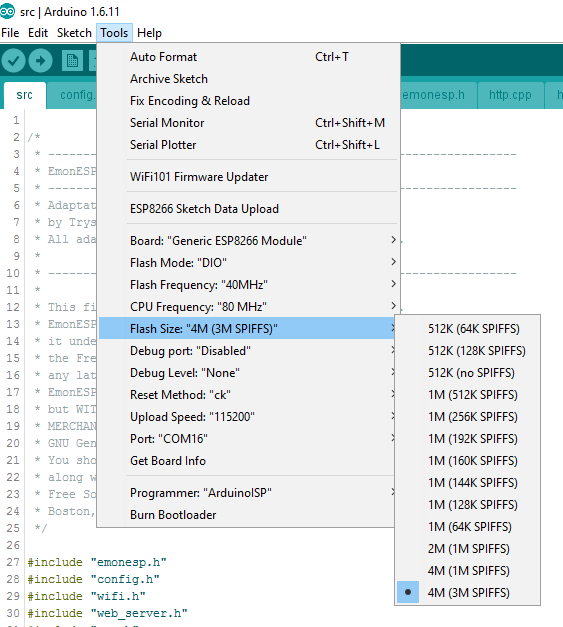So I’ve tried to set up emonESP on a Huzzah using via the Arduino IDE and not made much progress.
Whilst I am very much a novice with esp8266, I have previously set up and used an Arduino IDE with an Olimex ESP8266 and played with a generic ESP-12 some months ago but progress was slow and I moved on to other more pressing projects.
I use the Arduino IDE a lot and am familiar with most aspects of it. I have updated the IDE a few times since my original brush with ESP8266 and therefore start again with adding esp via the boards manager, so all fresh and latest builds.
I have followed the “Option 2: Using Arduino IDE” part of the EmonESP readme and had no issues beyond the ESP8266FS folder unpacking to <home_dir/Arduino/tools/ESP8266FS/ESP8266FS/tool/esp8266fs.jar instead of <home_dir/Arduino/tools/ESP8266FS/tool/esp8266fs.jardue having created the ESP8266FS dir as instructed in the prior step, but that was easily fixed once I went to use the tool and found it wasn’t on the menu.
Do have a couple of question’s though.
- “Install Arduino IDE 1.6.8 from the Arduino website” why? is there an issue with later builds? or should that be >1.6.8?
- “Select Tools > Board > Generic ESP8266 Module (required for EmonESP)” again, why? is there a difference? one would naturally assume if your exact board is listed, that might be the bast tool for the job.
- Having selected “Generic ESP8266” what other settings are required, because there are a few!
The default “512K (64K SPIFFS)” looked obviously wrong so I took a guess at “4M (3M SPIFFS)” as the Huzzah is a 4M device and the emonesp code has apparently run on a 512K device so 1M should suffice, should it be “4M (1M SPIFFS)” ? As for the other 7 settings I just went with the defaults you see.
One of my initial failed compiles was due to not having the “MQTT Lib” installed, I have now remedied that but for other “first timers” it might be useful to list the dependencies and/or how to include how to install the needed libs.
After a few false starts I was able to compile and upload to the esp8266, but have not been able to upload the data folder. Am I missing something, The file is now correctly located and the tool is listed in the menu after a IDE restart, but still no cigar!
The instructions step seems quite straight forward “Upload ‘data’ folder: Upload data folder (home.html web page etc) using tools > ESP8266 Sketch Data Upload tool.” But it doesn’t work. Even with both verbose compile and verbose upload set in the IDE’s preferences, this is all I have to go on.
`Arduino: 1.6.11 (Windows 10), Board: “Generic ESP8266 Module, 80 MHz, 40MHz, DIO, 115200, 4M (3M SPIFFS), ck, Disabled, None”
[SPIFFS] data : C:\Users\paulb\OneDrive\Documents\Arduino\EmonESP\src\data
[SPIFFS] size : 3052
[SPIFFS] page : 256
[SPIFFS] block : 8192
/config.js
/home.html
/style.css
[SPIFFS] upload : C:\Users\paulb\AppData\Local\Temp\builda6e400cad64a03f9af6b67e54a7cc6dd.spiffs/src.spiffs.bin
[SPIFFS] address: 0x100000
[SPIFFS] reset : ck
[SPIFFS] port : COM16
[SPIFFS] speed : 115200
warning: espcomm_sync failed
error: espcomm_open failed
error: espcomm_upload_mem failed
SPIFFS Upload failed!`
I can see the “emonESP_28481” wifi AP on my mobile and seem to be able to connect to it without any password but the guides “First Setup”
“On first boot, ESP should broadcast a WiFI AP emonESP_XXX. Connect to this AP and the captive portal should forward you to the log-in page. If this does not happen navigate to http://192.168.4.1” (obviously?) doesn’t happen and manually navigating results in an expected “/home.html not found, have you flashed the SPIFFS?”
I am using the “code_split_up_cpp” branch of emonESP and have v1.6.11 Arduino IDE installed.
Any pointers, anyone?
